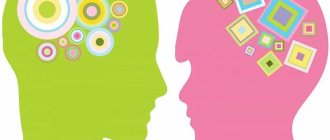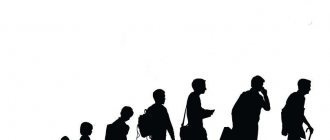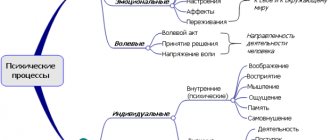Main types of mental phenomena
All existing mental phenomena are very closely interrelated, but they can be divided into main groups:
- mental processes;
- mental properties of personality;
- mental states.
This is the traditional classification of mental phenomena. In this case, mental processes are considered as basic phenomena, and the properties of the human personality and mental states are considered as temporary, typological modifications of mental processes. Taken together, all existing mental phenomena form an integral reflective-regulatory activity.
The structure of human psychological phenomena..
Modern ideas most closely correspond to the latest version; accordingly, we will accept the following as a working definition of the psyche: the psyche is the ability of higher nervous activity to create models of reality, which performs an adaptive function. This definition emphasizes the connection of the psyche with its material basis - the nervous system as the organic basis of nervous activity.
The psyche, as the repository of the “model of reality,” organizes information coming from the external environment in a special way and reacts to this constructed reality in its own way. Let us clarify this idea: our perception is a reflection of objective reality, our thinking is capable of analyzing the past and foreseeing the future, but there are limits to these methods. limited by our needs and goals. We do not perceive all information, but only that which is important to us. Person perceives light radiation of a certain range and sounds of a strictly certain height, and these spectra make up only a small fraction of those existing in nature, they are much narrower than those perceived by the animals of our planet, but this is precisely the range that is important for us. In the same way, in any everyday situation, each of us pays attention to and reacts only to those stimuli that are important to him personally. So, imagine a bus stop in the city center. One person who is late for something will react only to the approaching transport in search of the desired route number and think about the possible consequences of his lateness; another person, who is not in a hurry, at the same stop will begin to look at the people passing by, perhaps he will overhear someone’s conversation or observe a quarrel, maybe he will pay attention to an unusual car, smoke and decide who to visit; for the third, the bus driver, the stop is just one of the usual attributes of an everyday work situation. See how different the perceptions and emotional experiences of three people are in the same place and time period.
Thanks to the development of the adaptive function of the psyche, living beings became more adapted to survival than their ancestors. Compare: a lizard can remember a place that poses a danger, for example, a trap in the corner of the garden, but is not able to differentiate the danger itself (the trap) and the place (the corner of the garden), while a dog distinguishes well the source of danger and can easily identify a dangerous object in any place, which gives her undoubted advantages for survival. Humanity, with its culture, knowledge and technology, has gone beyond the animal world; its ability to survive is much higher: people. able to survive in polar cold conditions, in the desert, and even in outer space; with the modern level of medicine, he can live with diseases that previously or under other conditions would have been fatal. All these achievements that made people. super-adapted for survival, became possible thanks to the development of the psyche: memory, fantasy, speech, thinking. The adaptive function is also revealed through the fact that the psyche, as a carrier of programs acquired during life and quite easily corrected, reacts flexibly to changing environmental conditions.
Like any other science, psychology discovers the laws of the functioning of the psyche. Let us consider the main ones in order to understand how mental activity proceeds. The psyche has a hierarchical structure, that is, it consists of interconnected and mutually subordinate structural elements. These elements can be divided into three conditional groups: mental processes, states and properties. 15. Adaptive concept of the emergence and development of the psyche. Congenital forms of behavior.
Psyche is a property of highly organized living beings that exists in various forms and is a product of their life activity, ensuring their orientation and activity. This means that the emergence and development of the psyche is alive. world was subject to the general law of evolution, according to which what was biologically useful was fixed. The following were identified as the main trends in the development of the psyche: 1) complication of forms of behavior - forms of motor activity;
2) improvement method. to individual learning;
3) complication of forms of mental reflection (as a consequence and a factor of previous trends).
Behavior is the inherent interaction of living beings with the environment, mediated by their external (motor) and internal (mental activity). There are 6 levels of behavior: from such innate stereotypical forms of adaptation as taxis and reflexes, instinctive behavior, to acquired, modifiable forms associated with thinking (rational activity, learning, imprinting.).
Taxis are single-celled creatures located at the lower end of the stomach ladder and have complex behavior. For example, paramecia is a tiny organism, barely visible to the eye, living in ponds and puddles, equipped with a mouth, and has areas on its surface that are sensitive to stress, heat, touch, etc. Taxis is the reaction of a living organ to a certain stimulus. They are usually characteristic of unicellular organs that lack a nervous system, but are also observed in species with a higher organization (worms and insects). Insects fly towards the light in the evening - a typical manifestation of taxis. A reflex is a reaction to the excitation of receptors, mediated by the nervous system, a natural response of an organ to a stimulus. The concept of it was introduced by the French philosopher Rene Descartes. There are unconditioned (innate reflexes) - a hereditarily fixed stereotypical form of response to biologically significant influences of the external world or to changes in the internal environment (introduced by I.P. Pavlov) and conditional (acquired) - formed when any initially indifferent stimulus approaches in time with subsequent action stimulus that evokes an unconditioned reflex. Example: the production of saliva in a dog to the sound of a bell. There are 2 types of conditioned reflexes: classical, obtained using the above method; instrumental, during the development of which unconditional reinforcement is given only after the occurrence of a certain motor reaction of the animal.
Instinctive behavior is a set of behaviors formed during the development of a given species. - in phylogenesis - hereditarily fixed. innate behavioral components common to all representatives of a given species. During development, instant behavior is formed in combination and interaction with learning processes, but does not require exercise, it is maintained without periodic reinforcement and is stable. For example: pigeons have a special way of drinking (drinking with their heads thrown back) and only pigeons draw in water with their beaks with their heads down.
16. Adaptive concept of the emergence and development of the psyche. Acquired forms of behavior.
Psyche is a property of highly organized living beings that exists in various forms and is a product of their life activity, ensuring their orientation and activity. This means that the emergence and development of the psyche is alive. world was subject to the general law of evolution, according to which what was biologically useful was fixed. The following were identified as the main trends in the development of the psyche: 1) complication of forms of behavior - forms of motor activity;
2) improvement method. to individual learning;
3) complication of forms of mental reflection (as a consequence and a factor of previous trends).
Behavior is the inherent interaction of living beings with the environment, mediated by their external (motor) and internal (mental activity). There are 6 levels of behavior: from such innate stereotypical forms of adaptation as taxis and reflexes, instinctive behavior, to acquired, modifiable forms associated with thinking (rational activity, learning, imprinting.
Imprinting - imprinting a special form of behavior was discovered by the Austrian ethologist K. Lorenz. Example: goslings hatched from an egg in an incubator. The first moving object for them was K. Lorenz himself, and not the mother goose. When the goslings reached sexual maturity, they did not show any attention to the geese, but gave preference to people, i.e. attachment is imprinting. The imprinting mechanism is important for survival. because in natural conditions, the first moving object becomes a model that makes it possible to adequately demonstrate the forms of behavior inherent in a given species.
Learning - J. Godefroy, according to the degree of participation in the appropriation of experience, distinguishes 3 categories of learning: reactive, operational, cognitive. In the first case, the body reacts passively to external influences in the human nervous system. changes in neural circuits occur involuntarily and new memory traces are formed. With the second, it is necessary for the body to actively “experiment” with the environment. This is learning through trial and error, by forming reactions and by observation. In the third, learning involves assessing the situation taking into account past experience and its possible consequences (latent learning, development of psychomotor skills, learning by reasoning).
Rational activity is the ability of higher mammals, mainly humans and monkeys, allowing them to solve problems without preliminary manipulations, thanks to the high level of brain development. Example: a hungry chimpanzee sitting in a cage is able to quickly take possession of a banana lying near the cage if it is tied to a rope, the end of which is in the cage next to the chimpanzee. Comparative characteristics of the human psyche. and belly. presented in the following conclusions by Yu. B. Gippenreiter: 1) all activity of the abdomen. be determined by biological motives (A. Gelb “An animal cannot do anything senseless. Only humans are capable of this.”).
2) All activity is belly. limited to clear concrete situations. They are not able to plan their actions, to be guided by the “ideally” presented goal (an example of the lack of production of products for future use). 3) The basis of behavior is the stomach. in all spheres of life, including language and communication, constitute hereditary species programs. Their learning is limited to the acquisition of individual experience. thanks to which species programs adapt to the specific conditions of an individual’s existence. 4) At the stomach. there is no consolidation, accumulation and transmission of the experience of generations in material form, i.e. in the form of material culture.
⇐ Previous2Next ⇒
Recommended pages:
Mental processes
Mental processes are separate integral acts of reflective-regulatory activity. A certain mental process has its own object of reflection, its own regulatory features and proceeds in accordance with its own laws. Mental images are formed on the basis of mental processes.
Are you an expert in this subject area? We invite you to become the author of the Directory Working Conditions
Definition 1
A mental process is an active interaction between a reflected object and a subject, a system of special actions that are aimed at cognition of the object and the implementation of interaction with it
Mental processes are divided into types:
- educational,
- strong-willed,
- emotional.
The totality of volitional, cognitive, and emotional processes constitutes the mental activity of an individual.
Mental conditions
Definition 2
A mental state is the temporary uniqueness of mental activity, which is determined by its content, as well as the attitude of the person himself to this content. A mental state is a current modification of human mental activity and represents a stable integration of an individual’s mental manifestations in a specific interaction with reality.
Finished works on a similar topic
Course work Classification of mental phenomena 430 ₽ Abstract Classification of mental phenomena 220 ₽ Test work Classification of mental phenomena 240 ₽
Receive completed work or specialist advice on your educational project Find out the cost
The mental state manifests itself in the general functional level of mental activity, which depends on the person’s activity at a certain moment and the characteristics of his personality.
Mental states can be divided into the following types:
- motivational, based on the needs of the attitude, that is, on desires, interests, passion, attraction;
- states of organized consciousness, manifested in different levels of performance and attentiveness;
- emotional, implying the emotional tone of sensations, emotional response to the surrounding reality, mood, emotional states of a conflict nature;
- volitional, including states of initiative, determination, purposefulness, and perseverance.
Borderline mental states of a person are distinguished separately:
- reactive, including shock and stupor;
- neuroses;
- character accentuations;
- psychopathy;
- states of mental retardation.
Disadvantages of traditional classification
It should be noted that the traditional classification of mental phenomena, coming from Kant, although it is the basis for the construction of traditional psychology, has its drawbacks. This classification is characterized by an artificial separation of mental processes from the typological properties of personality and mental states. In reality, cognitive, emotional and volitional processes are certain mental capabilities of the individual, and mental states are the current uniqueness of these capabilities.
Get paid for your student work
Coursework, abstracts or other works
Relationship between psychology and other sciences
Philosophy. The greatest philosopher of antiquity, Aristotle, is considered the founder of psychology. Philosophy is a system of views on the world and man, and psychology is the study of man. Therefore, until recently, psychology was studied in philosophy departments of universities, and some of its sections (for example, general psychology, where definitions of the basic concepts of science are given) are closely intertwined with philosophy. However, psychology cannot be the “handmaiden of philosophy,” as was the case in the Soviet Union, where Marxist-Leninist philosophy strictly defined the basic postulates of psychology. These are two independent sciences that can mutually enrich and complement each other. At the intersection of philosophy and psychology there is such a branch of the latter as “General Psychology”.
Natural science is closely related to psychology. The development of theoretical and practical psychology in recent years would have been impossible without advances in biology, anatomy, physiology, biochemistry and medicine. Thanks to these sciences, psychologists better understand the structure and functioning of the human brain, which is the material basis of the psyche. “Psychophysiology” is located at the intersection of physiology and psychology.
Sociology, as an independent science, is closely related to social psychology, which is the bridge that connects the thoughts, feelings and attitudes of individuals with the phenomena of mass consciousness. In addition, sociology provides psychology with facts about the social activities of people, which are then used by psychology. The connection between psychology and sociology is provided by “Social Psychology”.
2 pages, 631 words
Psychology of a successful personality
... “crimes”, you will learn a lot about punishments. The lesson is taught by law teacher I.R. Mingazov. Psychology of a successful personality Knowing yourself is sometimes more difficult than studying the secrets of the universe. How to overcome internal...
Technical sciences are also related to psychology, since they often have the problem of “docking” complex technical systems and humans. These issues are dealt with by “Engineering Psychology” and “Occupational Psychology”.
History. Modern man is a product of historical development, during which the interaction of biological and mental factors took place - from the biological process of natural selection to the mental processes of speech, thinking and work. Historical psychology studies changes in the psyche of people in the process of historical development and the role of the psychological qualities of historical figures on the course of history.
Medicine helps psychology better understand the possible mechanisms of mental disorders in people and find ways to treat it (psychocorrection and psychotherapy).
At the intersection of medicine and psychology there are such branches of psychology as “Medical Psychology” and “Psychotherapy”.
Pedagogy provides psychology with information about the main directions and patterns of training and education of people, which makes it possible to develop recommendations for the psychological support of these processes. The connection between these related sciences is provided by “Educational Psychology” and “Developmental Psychology”.









